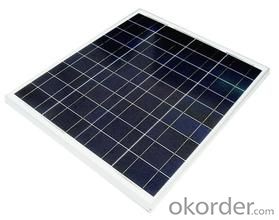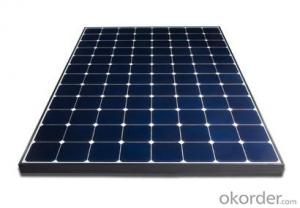CNBM Poly 195W Solar Panel with TUV UL CE Certificate For Residential
- Loading Port:
- Shanghai
- Payment Terms:
- TT OR LC
- Min Order Qty:
- 100 watt
- Supply Capability:
- 1000 watt/month
OKorder Service Pledge
OKorder Financial Service
You Might Also Like
Item specifice
CNBM Poly 195W Solar Panel with TUV UL CE Certificate For Residential
Introduction
Electrical connections are made in series to achieve a desired output voltage and/or in parallel to provide a desired current capability. The conducting wires that take the current off the modules may contain silver, copper or other non-magnetic conductive [transition metals]. The cells must be connected electrically to one another and to the rest of the system. Externally, popular terrestrial usage photovoltaic modules use MC3 (older) or MC4 connectors to facilitate easy weatherproof connections to the rest of the system.
Each module is rated by its DC output power under standard test conditions, and typically ranges from 100 to 365 watts. The efficiency of a module determines the area of a module given the same rated output – an 8% efficient 230 watt module will have twice the area of a 16% efficient 230 watt module. There are a few solar panels available that are exceeding 19% efficiency. A single solar module can produce only a limited amount of power; most installations contain multiple modules. A photovoltaic system typically includes a panel or an array of solar modules, a solar inverter, and sometimes a battery and/or solar tracker and interconnection wiring.
Micro-inverted solar panels are wired in parallel which produces more output than normal panels which are wired in series with the output of the series determined by the lowest performing panel (this is known as the "Christmas light effect"). Micro-inverters work independently so each panel contributes its maximum possible output given the available sunlight.[6
Suggested application
Home lighting business lighting,
Garden lighting, pavement lighting
Farmer household lighting
Decorative water pump
Traffic signal lighting
Industry area
Business area
Solar Power Plant
Product feature
Modules are made of Monocrystalline or Polycrystalline Silicon cell.
Materials and color of the solar panel frame: Clear anodized aluminum alloy type 6063T5 Universal frame; Silver-white color;
The output connection gathers the coupling: Selects conforms to the IEC-612615; 2005, class II, IEC61730 international standard; Airtight waterproofing binding clamp;
Module seal structure: The surface is thick, the high diaphanous rate armored glass with solar cell board special-purpose 3.2mm becomes after the high temperature lamination craft. The back selects has waterproof and anti- aged performance fine TPT materials. The entire block battery board has, the waterproofing, the anti- aging airtight and so on the fine performance;
Power tolerance: +/-3%
Packaging
International standard cartons (according to the requirements of customers)
- Q:Can solar panels be used to power an entire home?
- Yes, solar panels can be used to power an entire home. With the right number of solar panels and a proper energy storage system, it is possible to generate enough electricity to meet the energy needs of a household. However, it is important to consider factors such as energy consumption, geographical location, and system size to determine if solar panels alone can entirely power a home.
- Q:Can solar panels be installed on a greenhouse?
- Yes, solar panels can be installed on a greenhouse. In fact, it is a popular practice to install solar panels on greenhouses as it allows for sustainable energy production while utilizing the available rooftop space. The solar panels can help power the greenhouse's electrical systems, such as ventilation, lighting, and irrigation, reducing reliance on external energy sources. Additionally, the panels can provide shade and protection to the greenhouse, helping to regulate temperature and improve overall energy efficiency.
- Q:Can solar panels be used for powering a research facility or laboratory?
- Yes, solar panels can be used to power a research facility or laboratory. Solar panels convert sunlight into electricity, providing a sustainable and renewable source of energy. By harnessing the power of the sun, solar panels can generate enough electricity to meet the energy demands of various equipment and appliances used in research facilities and laboratories. Additionally, solar panels can be combined with energy storage systems to ensure continuous power supply even when sunlight is not available.
- Q:I am looking at building my own solar panels to at least help cut down the rising energy bill. I know its expensive. I already have the solar cells so no need to worry about listing that. But i am looking at wiring it directly into the house. Is there any parts that you could list for me, that would be great. thanks
- You're missing a few assumptions: - where on the globe? - how well is your house insulated, how do you plan to heat/cool your house? - why do you insist on power wasting appliances like plasma screens? Usually, unless it's absolutely impossible, a grid-tie-in system is much better than an insular system. You could use the grid to 'store' electricity for those times when the sun isn't shining and as fall-back if your yield isn't quite as good as you calculated. With the battery system, you'll have to specify your reliability requirements. If you want a 00% guarantee that you'll always have electricity, even if the sun is not shining for a week longer than you've planned according to the past weather history of your area, you'll either have to ridiculously oversize your battery (and panel) system, or plan for some sort of backup system anyway. Finally, if you're really planing such a system, you might want to take a look at the fridges and freezers used on sailboats: these use a eutectic cold accumulator, i.e. you 'charge' the fridge when the engine is running (or the sun is shining) and it'll then keep the temperature for another ~2...35 (professional systems) hours.
- Q:What is the average size of a residential solar panel system?
- The average size of a residential solar panel system is typically around 5 kilowatts (kW), which is equivalent to approximately 20 solar panels. However, the size may vary depending on factors such as energy consumption, roof space, and individual preferences.
- Q:Can solar panels be installed on a barn or shed?
- Yes, solar panels can be installed on a barn or shed. In fact, barns and sheds are often ideal locations for solar panel installations due to their large, open rooftops that receive ample sunlight. Installing solar panels on a barn or shed can help generate clean and renewable energy while utilizing otherwise unused space.
- Q:Do solar panels require direct sunlight to work?
- No, solar panels do not require direct sunlight to work. They can still generate electricity from indirect sunlight or even on cloudy days.
- Q:Can solar panels be used to power a museum?
- Yes, solar panels can be used to power a museum. Solar panels capture sunlight and convert it into electricity, which can then be used to power various electrical systems within the museum. This sustainable energy source can help reduce reliance on traditional grid electricity and lower the museum's carbon footprint. Additionally, advancements in solar technology have made it more efficient and cost-effective, making it a viable option for powering both small and large-scale facilities like museums.
- Q:Can solar panels be used in areas with high levels of shade?
- Solar panels can still be used in areas with high levels of shade, but their efficiency may be significantly reduced. The shade from trees, buildings, or other obstructions can block sunlight from reaching the panels, limiting their ability to generate electricity. However, there are advanced technologies and strategies available, such as microinverters or optimizers, that can help mitigate the impact of shade and improve panel performance in shaded conditions.
- Q:so...do you think an online store dedicated to selling solar panels/systems will be a good business idea? Since green energy is the 'hottest' growing business area recently with usage growing about 30% per annum and investors putting all their money into solar energy, wind farms, biofuel, etc. I think when you sell solar systems online this will be the most appealing business model to the end customer...especially if you offer free installation on orders of say $000.
- Presently the technology is not there using green energy. Green energy is popular, but not as effecient as they claim. There is no product today whether it is electric cars, windmills, solar panels that have a lucrative payback. They all have their drawbacks. Your thinking is good, but the market and the techology just isn't there yet. If it were, you would see solar panels on every house. You already have the competition as you noted, and they aren't prospering... Good luck.
1. Manufacturer Overview |
|
|---|---|
| Location | |
| Year Established | |
| Annual Output Value | |
| Main Markets | |
| Company Certifications | |
2. Manufacturer Certificates |
|
|---|---|
| a) Certification Name | |
| Range | |
| Reference | |
| Validity Period | |
3. Manufacturer Capability |
|
|---|---|
| a)Trade Capacity | |
| Nearest Port | |
| Export Percentage | |
| No.of Employees in Trade Department | |
| Language Spoken: | |
| b)Factory Information | |
| Factory Size: | |
| No. of Production Lines | |
| Contract Manufacturing | |
| Product Price Range | |
Send your message to us
CNBM Poly 195W Solar Panel with TUV UL CE Certificate For Residential
- Loading Port:
- Shanghai
- Payment Terms:
- TT OR LC
- Min Order Qty:
- 100 watt
- Supply Capability:
- 1000 watt/month
OKorder Service Pledge
OKorder Financial Service
Similar products
New products
Hot products




























